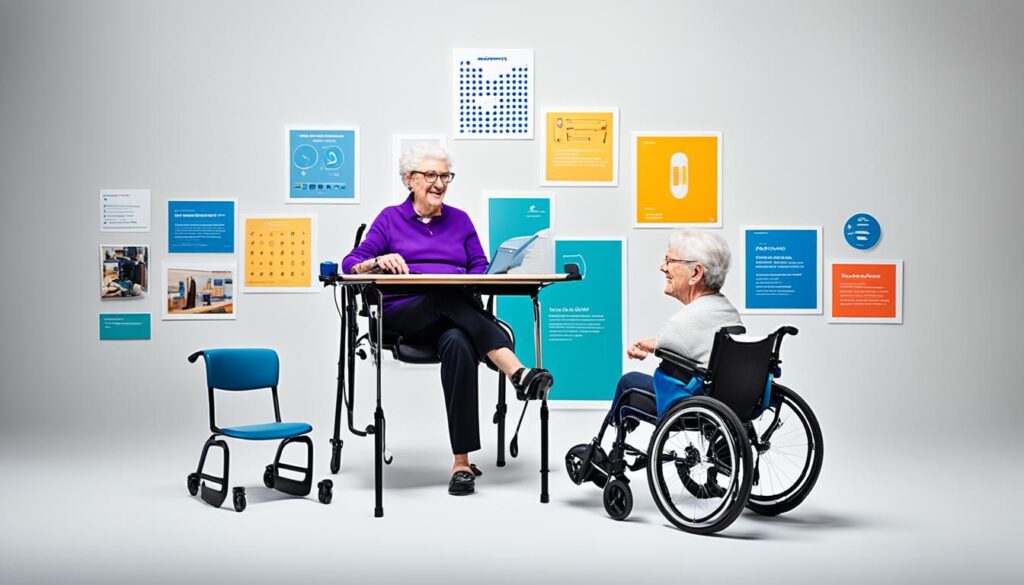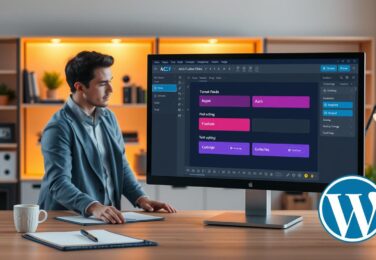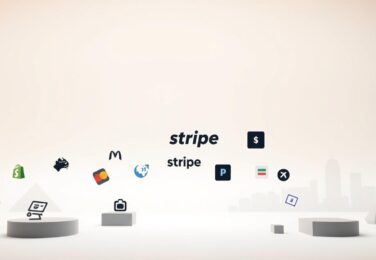Accessibility Development: Creating Inclusive Tech

Table of Content
I’m an Aussie who loves making tech for everyone, no matter their abilities. Growing up, I saw how digital barriers left people with disabilities behind. I wanted to help change that. Now, I’m thrilled to share our work in making tech more accessible for all Australians.
We’ll talk about making tech easy for everyone to use, following WCAG rules, and the importance of a good user experience. We’ll look at new tech that helps people with different needs. Join us as we work to make the internet a place where everyone can thrive.
Key Takeaways
- Accessibility development is crucial for creating inclusive tech solutions in Australia.
- Understanding the principles of accessible design is key to removing barriers and enhancing digital experiences.
- WCAG compliance ensures digital platforms adhere to industry standards for accessibility.
- User experience (UX) plays a vital role in designing for diverse abilities and improving usability.
- Assistive technologies are transforming the way individuals with disabilities interact with digital content.
Embracing Web Accessibility for All
Web accessibility means making sure digital stuff is easy for everyone to use, no matter their abilities. It’s not just about following rules. It’s about making sure everyone can join in and do well online.
Understanding the Importance of Inclusivity
Technology is a big part of our lives now. We need to think about how people with disabilities use it. Web accessibility means making sure everyone can easily get to and use online stuff.
Removing Barriers to Digital Experiences
Some online places make it hard for people with disabilities to use them. We need to get rid of these barriers. This way, everyone can use the web without trouble.
By working on web accessibility and making things more inclusive, we can make the internet better for everyone. It’s important for making sure everyone has the same chances online. This helps make the internet a fair place for all Australians.
“Accessibility is not just about compliance – it’s about empowering individuals and fostering an inclusive online environment where everyone can participate and thrive.”
Principles of Accessible Design
Accessible design makes digital experiences for everyone. It’s about removing barriers so all can use our products and services. By following these key principles, we make the digital world more inclusive and welcoming.
Clear and intuitive navigation is key. We make interfaces easy to understand with logical structures. Accessible design makes sure users can navigate with just a keyboard, helping those who need assistive tech or have motor issues.
Ensuring content is easy to see is also vital. We use high-contrast colors and clear fonts. Accessible design helps users with visual, auditory, or cognitive disabilities understand and engage with content.
The goal of accessible design is to make UX inclusive, friendly, and follow WCAG standards. By doing this, we create digital spaces where everyone can access info, do tasks, and fully join in the digital world.
“Accessible design is not just about compliance; it’s about creating experiences that are inclusive, empowering, and benefit everyone.”
| Principle | Description |
|---|---|
| Clear and Intuitive Navigation | Designing interfaces with logical structures and straightforward pathways for users to find information or functionality. |
| Keyboard-only Interactions | Enabling users to navigate and interact with digital content without the use of a mouse, catering to those with motor impairments or who rely on assistive technologies. |
| Easily Perceivable Content | Using high-contrast color schemes, legible typography, and providing text alternatives for non-text elements like images and videos. |
Accessibility Development: A Guiding Light
At the heart of accessibility development is the aim to make digital experiences for everyone. We start with accessibility in mind to make sure our work is for all. This way, we remove barriers and help people with different abilities use our products easily.
Incorporating Accessibility from the Start
We don’t just add accessibility later. We put it at the core of making and designing things. This means we tackle accessibility issues early, making sure our work meets WCAG compliance. This way, everyone can enjoy our work.
Continuous Improvement and Testing
Our work on accessibility doesn’t end. We keep making it better and testing it to stay current. We check our products often, listen to user feedback, and do accessibility testing. This helps us keep improving our inclusive design and lead in accessibility development.
“Accessibility is not just a legal requirement, but a moral imperative. It’s about empowering everyone to access and engage with the digital world.”
We believe that accessibility development is key to a digital world that welcomes everyone. By focusing on accessibility and always improving, we make experiences that value diversity. This helps everyone feel they belong.
Assistive Technologies: Bridging the Gap
At the forefront of making the web more accessible are the latest assistive technologies. These tools help people with disabilities use digital spaces better. They include screen readers and voice control systems, changing how we use technology. This makes the internet more welcoming for everyone.
Screen Readers and Keyboard Navigation
For those who can’t see, screen readers are key to accessing digital content. They turn text and images into speech or braille. This lets users move through websites and apps easily.
Keyboard navigation is also crucial for accessibility. It lets people with physical disabilities use the internet without a mouse. This makes digital tools more accessible to everyone.
Voice Control and Alternative Input Methods
New technologies like voice control and alternative input are changing how people interact with the internet. Voice recognition lets users control devices with just their voice. Devices like eye-trackers and adaptive keyboards offer new ways for people with physical or motor issues to interact.
By using these technologies, we can make the web more inclusive. This means everyone can enjoy digital experiences without barriers. As technology advances, we’re getting closer to making the internet accessible to all.

WCAG Compliance: The Industry Standard
WCAG (Web Content Accessibility Guidelines) is now the top rule for making web content accessible to everyone. As Australians, we must follow these guidelines to make sure our online stuff is for all users. This makes the internet better for people with different abilities.
WCAG gives clear steps for web developers and designers. By using WCAG, we know our work is good for everyone. This makes our sites better for people with disabilities and improves the experience for all users.
The WCAG guidelines look at many things, like making sites work with screen readers and keyboards, and making text easy to read. Following these rules helps remove obstacles. This way, all Australians can easily use the internet and its many services.
Using WCAG for inclusive design is a must. As we keep improving our accessibility development, let’s focus on making the internet better for everyone. By doing this, we help everyone to fully enjoy and use the online world.
User Experience (UX) and Accessibility
Creating digital spaces that everyone can use is key. It’s where user experience (UX) and accessibility meet. We aim to make sure all users can easily use our digital stuff.
Designing for Diverse Abilities
Accessibility is more than just following rules. It’s about helping people with different disabilities use our digital stuff easily. We focus on making designs that work for everyone, including those with visual, auditory, motor, or cognitive impairments.
Usability Testing with People with Disabilities
Testing how easy things are to use is crucial for accessibility. We make sure people with disabilities help us test our stuff. They give us real feedback and help us fix problems. This way, we make sure our digital stuff is really for everyone.
| Accessibility Principle | Key Considerations |
|---|---|
| Perceivable | Ensure content is presented in ways users can perceive, including providing text alternatives for non-text content. |
| Operable | Make all functionality available from a keyboard, provide clear visual focus indicators, and ensure users have enough time to read and use content. |
| Understandable | Write content in clear, simple language, provide context and orientation information, and ensure functionality is predictable. |
| Robust | Ensure content is compatible with a wide range of user agents, including assistive technologies, and maintain accessibility as content evolves. |

By focusing on user experience (UX) and accessibility, we make digital experiences better for everyone. Our designs are not just pretty but also easy and empowering for all. This approach is good for business too, as it helps reach a wide range of customers.
Accessible User Interfaces: Best Practices
Making our digital experiences inclusive is crucial. We follow best practices to make sure our interfaces are easy and powerful for everyone. Let’s look at two important parts of accessible design: colour contrast and text alternatives.
Colour Contrast and Text Alternatives
For users with visual impairments, proper colour contrast is key. We follow WCAG guidelines, which suggest a contrast ratio of 4.5:1 for normal text and 3:1 for large text. This makes text clear for those with low vision. Also, giving text alternatives for images and icons helps screen reader users and those with cognitive or learning disabilities.
Keyboard Accessibility and Focus Management
Keyboard accessibility is crucial for inclusive design. Everything should work with a keyboard, so users without a mouse can use our apps. It’s also important to manage focus well, making sure the user’s focus is clear and easy to move between interactive parts.
By following these best practices, we make accessible user interfaces that are inclusive and empowering for everyone. Using WCAG compliance and understanding web accessibility is key to creating digital experiences that welcome all.
Disability Inclusion: A Moral Imperative
Creating a digital world that includes everyone is a must. We believe that making disability inclusion a key part of our work helps build a fairer society. It lets people with disabilities fully join in and use digital tools without trouble.
Accessibility is more than just a tech issue; it’s a basic right. By using inclusive design, we can remove obstacles. This way, our digital solutions help everyone, including those with disabilities.
We’re not just following rules with accessibility development. It shows we value user experience (UX) deeply. We aim to make digital spaces easy and open for everyone, including those with disabilities.
“Accessibility is not just about compliance; it’s about creating a world where everyone can participate, contribute, and thrive.”
At our company, we see disability inclusion as a moral duty. By focusing on accessibility, we help people with disabilities and make the digital world better for everyone. This makes our online spaces more welcoming and full of life.
| Key Benefits of Disability Inclusion | Accessibility Development Principles |
|---|---|
|
|
Universal Design: A Holistic Approach
Universal design is all about making things accessible to everyone. It means creating products and places that people of all abilities can use easily. This approach goes beyond just following rules. It’s about designing with everyone in mind, making sure no one is left out.
Proactive Accessibility for All Users
Universal design is about adding accessibility features right from the start. It’s about thinking ahead for people with different abilities. This way, everyone can use our digital stuff without any trouble.
Designing for Situational Limitations
Universal design also covers temporary needs, not just permanent disabilities. It helps us think about how people might use our stuff in different situations. This makes our products and services better for everyone, no matter what.
By using universal design, we make the digital world more fair and open. Accessibility becomes a key part of designing things. This way, we make sure everyone can easily join in and use what we offer.
Accessibility Testing: Ensuring Compliance
We take making digital experiences accessible very seriously. We know that making things easy for everyone means paying close attention to details. That’s why we use accessibility testing to make sure our stuff works for everyone.
Our goal is to follow the WCAG compliance rules. This makes sure our products are open to all users. We aim for an experience that everyone can enjoy.
Automated and Manual Testing Methods
We use both automated and manual testing to check for accessibility. Automated tools help us find common issues fast. But, we also do manual testing with people who have disabilities.
This way, we catch things that automated tools might miss. It’s a thorough check to make sure our stuff is really accessible.
Involving People with Disabilities in Testing
We really believe in making things for everyone. That’s why we listen to people with disabilities. They help us make our designs better.
By working with them, we get feedback that makes our products better. It’s all about making sure everyone can use our stuff easily.
We’re always looking for new ways to make our products better for everyone. We’re dedicated to making digital spaces open to all. Our goal is to help everyone enjoy the digital world fully.
Conclusion
We’re working hard to make the digital world more accessible for everyone. By focusing on accessibility development and inclusive design, we’ve made big steps. Now, we’re making sure digital experiences work for all Australians.
We’ve learned a lot about web accessibility and why it’s key. Together, we’ve removed many digital barriers. Now, with the help of assistive tech and following WCAG standards, everyone can use our digital stuff.
We’re always improving, focusing on user experience (UX) and making sure everyone is included. We’re making sure our digital stuff works for everyone by listening to people with disabilities. This way, we’re making sure our digital solutions are for everyone.










